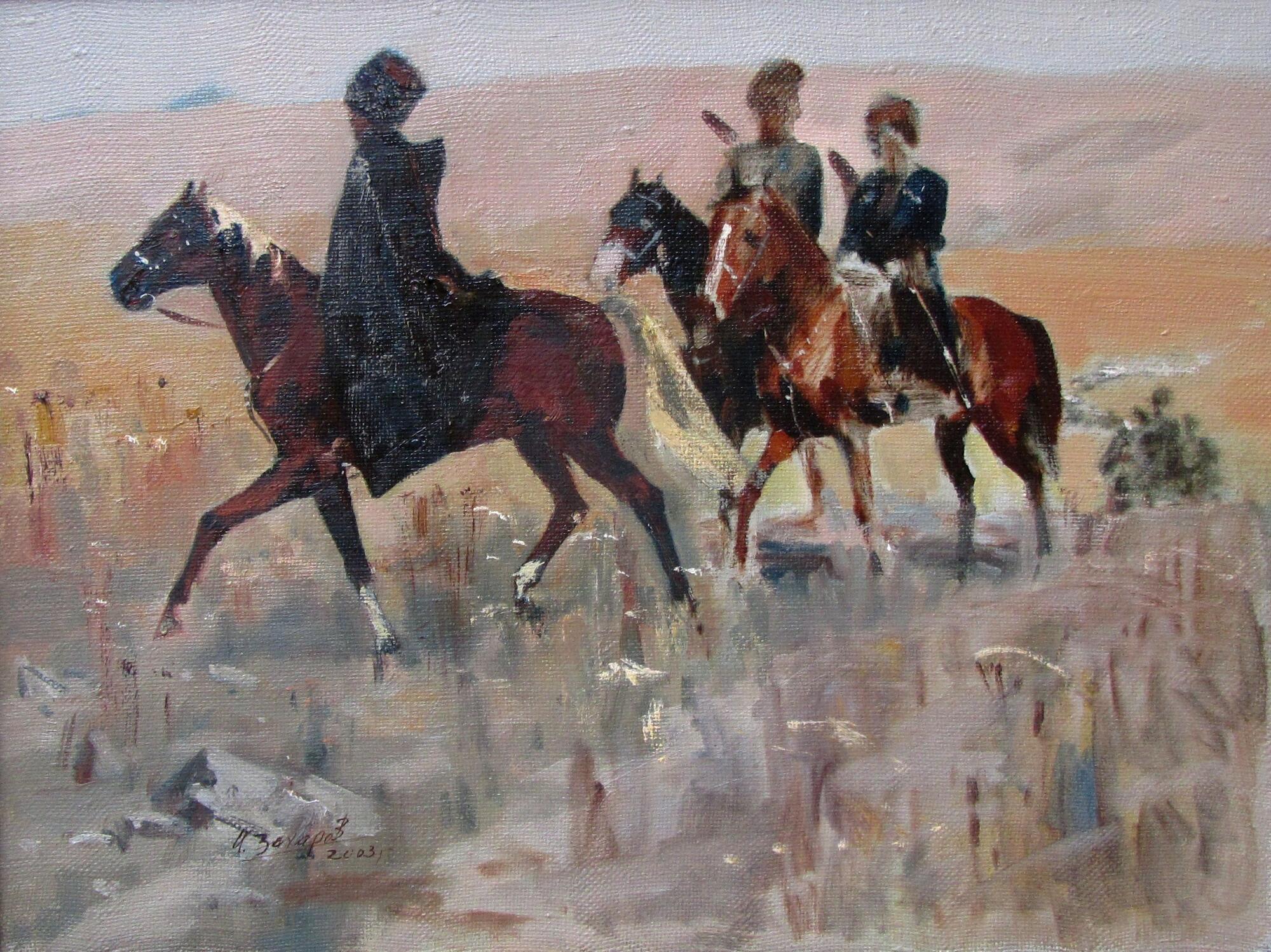The Realist painting “In the steppe” is displayed in the museum. Its author Ivan Zakharov used a restrained palette: the figures of people and horses are painted in dark brown colors, and the hilly steppe in the background in weak light tones. The absence of bright and contrasting colors on the canvas indicates that the scene most likely unfolds in the fall or early spring.
Zakharov painted the figures of Cossacks with rough, careless strokes, using few colors. He placed the emphasis on the horses: the animals are painted in detail, close-up. The author realistically conveyed the elegance and dynamic motions of the running horses.
Ivan Zakharov was born on August 6, 1936, in the village of Gorkaya Balka, Stavropol Krai. He developed an interest in drawing as a child. He studied by correspondence for four years at the Moscow People’s University named after Nadezhda Krupskaya, later graduated from the Fine and Graphic Arts Faculty of the Krasnodar Pedagogical Institute.
Zakharov participated in many exhibitions, taught, and in 1984 became a member of the Artists’ Union of the USSR. Zakharov dedicated many of his paintings to the Cossacks, their history and everyday life. The rider on a horse was one of the central motifs in the artist’s oeuvre.
A Cossack got his own horse very early, as a child. It accompanied him until his death. In the Don territories, people said about a deceased Cossack that he “tied his horse” or “went to catch unruly horses”.
Traditionally, the Cossacks rode the Russian Don horses, a special breed. An entry in the Brockhaus and Efron Encyclopedic Dictionary provides its description: “The Cossack horse is characterized by a humped head, a thin and long neck, a straight and strong back, a wide barrel, long and dry legs and generally a lean body and short stature <…>. It is distinguished by perseverance, endurance and unpretentiousness to the conditions of maintenance, sharp vision and far-sightedness, wildness of temper and quickness of movement.”
Zakharov painted the figures of Cossacks with rough, careless strokes, using few colors. He placed the emphasis on the horses: the animals are painted in detail, close-up. The author realistically conveyed the elegance and dynamic motions of the running horses.
Ivan Zakharov was born on August 6, 1936, in the village of Gorkaya Balka, Stavropol Krai. He developed an interest in drawing as a child. He studied by correspondence for four years at the Moscow People’s University named after Nadezhda Krupskaya, later graduated from the Fine and Graphic Arts Faculty of the Krasnodar Pedagogical Institute.
Zakharov participated in many exhibitions, taught, and in 1984 became a member of the Artists’ Union of the USSR. Zakharov dedicated many of his paintings to the Cossacks, their history and everyday life. The rider on a horse was one of the central motifs in the artist’s oeuvre.
The Cossacks treated their horses with reverence: in the Cossack culture, the horse was inseparable from the owner, it was considered a faithful companion and friend. Many proverbs and sayings about this connection are known: they confirm that a rider always takes care of his horse because he cannot be considered a Cossack without it. For example, “A Cossack without a horse is like a warrior without a gun”, “A Cossack’s best jewelry is his horse”, “A Cossack without a horse is an orphan”, “A Cossack is hungry but his horse is well fed”.
A Cossack got his own horse very early, as a child. It accompanied him until his death. In the Don territories, people said about a deceased Cossack that he “tied his horse” or “went to catch unruly horses”.
Traditionally, the Cossacks rode the Russian Don horses, a special breed. An entry in the Brockhaus and Efron Encyclopedic Dictionary provides its description: “The Cossack horse is characterized by a humped head, a thin and long neck, a straight and strong back, a wide barrel, long and dry legs and generally a lean body and short stature <…>. It is distinguished by perseverance, endurance and unpretentiousness to the conditions of maintenance, sharp vision and far-sightedness, wildness of temper and quickness of movement.”


